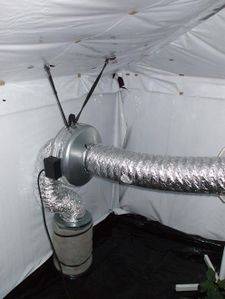kaljukajakas said:Asphalt roofing tiles or mat will work about as well as dynamat. You'll only need to use it if the hum coming off the walls of your cabinet is louder than your intake. The MDF itself is also pretty dense stuff. A layer of dense fiberglass mat on the walls might work better. Commercial fan boxes are built like that as well: the sheet steel is like the MDF, dense and smooth. If you hit it with noise it will start vibrating like a drum skin. Instead of using a lot more steel so it will take more sound pressure (of a lower frequency) to make it vibrate the designers put a layer of fibreglass mat on the inside so the sound will be absorbed and scattered before it hits the steel.
One of the tricks professional automotive sound insulation people use is layering different sound absorbing materials. For example: glue a layer of asphalt sheet on the walls, then glue a layer of dense felt mat or carpet on top of that, then glue on another layer of asphalt and yet another layer of felt. This should work better than an equivalent thickness of either material.
Air is louder the faster it has to move, so if you're pulling air in from the same room as the cabinet then you'd want to have as big of an intake as possible. I'd go for as many 4" holes in the cabinet wall or floor as will fit. Make a row of them in the rear of the cabinet and and fit the holes with say 2-3' long pieces of fiberglass pipe insulation. It'd basically be row of duct mufflers, put a 90 deg. bend in the top and it's a light trap as well. A 48" wide cabinet should fit six 4" ID duct mufflers in a row. Alternatively you could use 2" thick dense fiberglass sheets to build a light trap. Might be easier and you'd fit an even bigger intake in the same space.
On top of that I'd absolutely go for a huge carbon filter with a thick bed of carbon. As big as possible: a flat rectangular tray for the carbon the size of your cabinet bottom and fastened and sealed under the ceiling of the cabinet so all the air is sucked through it after going through the grow space. The entire top section of the cabinet would then become a filter housing (and utility space) if you seal off the cabinet in front and above the filter.
It'd work like this: air enters through the multiple intakes slowly and quietly, is sucked up through the carbon filter into the ceiling compartment and pushed down to the cooltube through a pipe going through the carbon layer, then exiting the cabinet through well insulated exhaust tubing. Thus intakes (and your ears) will be insulated from the fan noise by both the intake mufflers and the bed of carbon. Of course you'd still want to make an insulated box for the fan...
I'd also try to hermetically seal the doors so no noise gets through the cracks. This is why people who compete with cars that have very loud sound systems sometimes lean on their car windows when taking dB readings: unless the car interior is sealed a lot of sound will leak out through the smallest crack (a flexing window glass), making the interior much quieter.
In the end though, even if you use a 2 ton steel safe for your cabinet and fill the inside with goose down, it won't be completely quiet.
Awesome man, exactly the info I needed!!! I'm gonna try and rep+ you. If it does not work I will be back when I have a higher post count.
Lots of great info, I will post up what I end up doing!
Thanks
NiceShoes

 and the
and the  did not sway her over...
did not sway her over... Old Room Pics
Old Room Pics 




